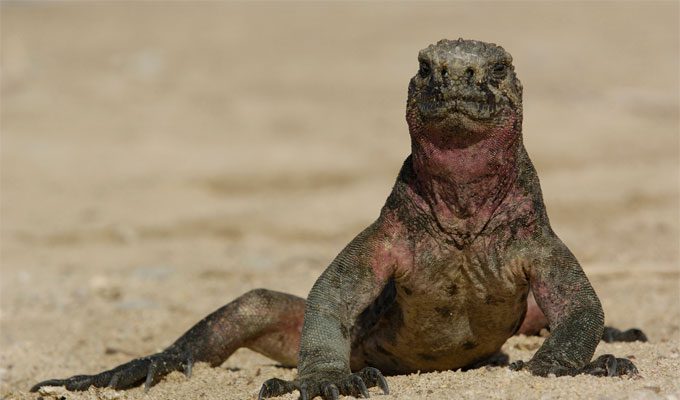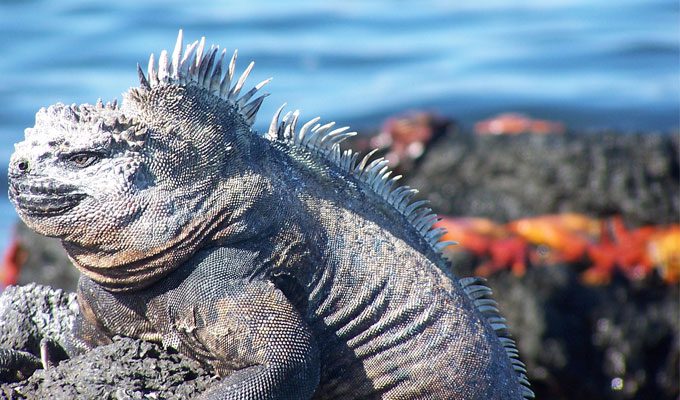Carefully stepping over these miniature dragon-like animals as they lazily lounge along the path, they do not appear to be much; even Charles Darwin doubted their importance, describing them as “hideous-looking” and “most disgusting, clumsy lizards.” However, the salt-spitting Galapagos marine iguana provides remarkable testimony to the process of evolution and is beautifully adapted to best exploit its environment.
TALK TO A DESTINATION EXPERT

Diego Zapata

Rosa Mena

Sandy Lara

Diego Zapata

Rosa Mena

Sandy Lara
General Description
It is estimated that the ancestor of the Galapagos marine iguana arrived in the islands several millions of years ago (possibly even 10.5 million), most likely drifting out on logs or piles of debris taken up by the strong ocean currents that flow towards the islands. The iguana has since spread to almost every island in the Galapagos, taking advantage of its beautiful beaches. However, as commonly occurs in the Galapagos, the marine iguanas vary ever so slightly in size, color, and shape across the archipelago, with seven recorded subspecies in total. This variation is particularly evident in their coloring. For example, Galapagos marine iguana on Santiago is significantly greener, while red iguanas are much more prominent on Española. Española marine iguanas are known for being the brightest subspecies, hence their nickname, the Christmas iguana.
Marine iguanas can be recognized by their wide-set eyes, laterally flattened tail, salt-encrusted heads, and their flat and square nose. Males have slightly brighter coloring, and their bodies are larger than the females´, growing to more than four feet long. They also have longer spines lining their backs, and can easily be recognized during the mating season, as their colors get considerably brighter.

Adaptations of the Galapagos Marine Iguana
Experts estimate that the Galapagos marine iguana evolved from its ancestor around 5.7 million years ago, and so many of the traits for which it can be so easily distinguished from its land-dwelling cousin (its nose, tail, coloring) are adaptations to better exploit its new environment, becoming expert swimmers in the process. Their flattened tail works as a rudder, allowing them to dive to the ocean floor and feed on the algae that grow on the rocks. Their flattened noses and sharp teeth enable them to scrape algae off rocks as they cling to them tightly with their long claws in order to fight the strong currents. In fact, they are able to stay underwater for up to an hour, although their dives typically last five to ten minutes.
Their bodies have also evolved to combat the cold, salty waters where they feed. Being cold-blooded creatures, the Galapagos marine iguanas are not able to thermoregulate their body temperature and are therefore restricted by how long they can stay in the cold ocean waters. Before feeding, the lizards must raise their body temperature to about 36°C, as they can lose up to 10°C when in the ocean, and they must also warm their bodies again following the dive. Consequently, the dark coloring of the iguanas is critical to allowing them to absorb sunlight. Additionally, as this is the only species of lizard that feeds in the ocean, it intakes significantly higher levels of salt than its body is used to, so its ancestors developed quite a unique way of getting rid of it. The Galapagos marine iguana has special glands connected to its nostrils that are able to clean the salt from their blood, which they then sneeze out.

However, perhaps the most fascinating adaption is their reaction to food shortages. The Galapagos Islands are highly affected by El Niño and La Niña climate fluctuations. During extreme El Niño events, the primary food source of the marine iguanas, algae, becomes severely depleted, disastrously affecting their population levels. During these times, the body of the iguana actually shrinks in size and then regrows again when food is once more plentiful. This is the first known reporting of the shrinking of an adult vertebrate. Furthermore, it can occur repeatedly throughout their lifetime. Experts believe that this shrinking occurs as a result of bone absorption. In other words, the Galapagos marine iguana actually consumes parts of their bones to stay alive. Furthermore, it helps the iguana to survive, as a smaller body requires less nutrition.

Javier Garcia

Eduardo Silva

Carolina Escobar
START PLANNING YOUR TRIP

Javier Garcia

Eduardo Silva

Carolina Escobar
Get in touch for more
CONTACT US
However, evolution is forever an ongoing process and, indeed, in recent years, experts have noticed new techniques that the iguanas have developed to survive during times of shortage. For example, in strong El Niño events, they have been seen consuming crustaceans and grasshoppers, as well as terrestrial vegetation on a few islands, but will this be enough in the struggle against increasingly extreme climate events? We can only hope.


